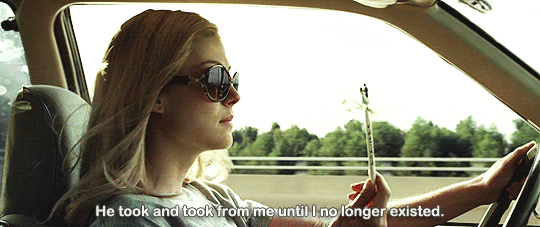Gone Girl is a 2014 film based of the novel by Gillian Flynn of the same name. The story revolves around the couple Nick and Amy. They appear to be the perfect couple to everyone around them, but in reality their marriage is extremely toxic. Amy is horribly unhappy in their marriage, and when she finds out Nick is having an affair with one of his students who is easily 15 years his junior, she reaches a boiling point. Amy begins to conspire to frame him for her own murder. This is one of my favorite films not only because of it's thrilling and dynamic plot, but for Amy's six minute monologue infamously known as the 'Cool Girl' speech.
Although Amy's rant on this "Cool Girl" persona is dark and undeniably disturbing, I found myself not only sympathizing, but agreeing with a lot of what Amy had to say during her monologue. She is sick with who she has become by marrying Nick. She truly believes that Nick has destroyed her and she deserves revenge. When you take out the whole framing your spouse for your own murder bit, Amy's monologue is intrinsically feminist and powerful. It speaks to all the women who feel like they need to dumb themselves down or act a certain way to keep a man. Amy has become exactly the kind of woman she doesn't want to be and she refuses to allow it any longer.
Another reason I cheered for Amy during the monologue is that in the beginning of the film, Nick appears to the viewers as a lying, cheating, and all together kind of shady guy. Viewers feel the need to be on her side. This sudden twist that Amy actually planned to frame Nick for her murder shifts the entire mood of the film. Suddenly, Amy is presented as this brilliantly psychotic mastermind, not the relatively flat character that she originally seemed.
Although Amy's rant on this "Cool Girl" persona is dark and undeniably disturbing, I found myself not only sympathizing, but agreeing with a lot of what Amy had to say during her monologue. She is sick with who she has become by marrying Nick. She truly believes that Nick has destroyed her and she deserves revenge. When you take out the whole framing your spouse for your own murder bit, Amy's monologue is intrinsically feminist and powerful. It speaks to all the women who feel like they need to dumb themselves down or act a certain way to keep a man. Amy has become exactly the kind of woman she doesn't want to be and she refuses to allow it any longer.
Another reason I cheered for Amy during the monologue is that in the beginning of the film, Nick appears to the viewers as a lying, cheating, and all together kind of shady guy. Viewers feel the need to be on her side. This sudden twist that Amy actually planned to frame Nick for her murder shifts the entire mood of the film. Suddenly, Amy is presented as this brilliantly psychotic mastermind, not the relatively flat character that she originally seemed.
 What makes this monologue so effective is Amy explaining everything that a Cool Girl is and should be juxtaposed with shots of Amy being everything that a Cool Girl isn't. Obviously, Amy isn't fueled by directionless rage. She may psychotic, but there is a point to what she has to say. Amy uprooted her entire life for Nick. She sacrificed so much in order to be with him. She even gives him money to open a less than successful bar. She gives and gives and gives to Nick, but he still betrays her. So, Amy plans to destroy everything that she's fabricated in order to get and keep Nick's attention. She also will destroy Nick, because in her mind Nick deserves to suffer like she's suffered.
What makes this monologue so effective is Amy explaining everything that a Cool Girl is and should be juxtaposed with shots of Amy being everything that a Cool Girl isn't. Obviously, Amy isn't fueled by directionless rage. She may psychotic, but there is a point to what she has to say. Amy uprooted her entire life for Nick. She sacrificed so much in order to be with him. She even gives him money to open a less than successful bar. She gives and gives and gives to Nick, but he still betrays her. So, Amy plans to destroy everything that she's fabricated in order to get and keep Nick's attention. She also will destroy Nick, because in her mind Nick deserves to suffer like she's suffered. |
| Example of washed out, greyed colors in the film |
 |
| Nick and Amy silhouetted as they fight |
Works Cited
Gone Girl. Dir. David Fincher. Twentieth Century Fox, 2014. Film.
Barsam, Richard and Dave Monahan. Looking at Movies. New York: W.W. Norton & Company,
2013. Print.


No comments:
Post a Comment